Abstract
The combined effects of trimethoprim and sulfamethoxazole on the viability of Escherichia coli K-12 and resistant strains possessing resistance plasmids were examined in minimal medium. When methionine, glycine, and adenine were present, sulfamethoxazole could enhance trimethoprim activity against E. coli K-12 so that the combination was bactericidal. However, this enhancement occurred over a narrow range of trimethoprim concentrations (0.04 to 0.2 mg liter-1) and only when the sulfamethoxazole concentration was more than 10 times that of trimethoprim. Under certain conditions, sulfamethoxazole enhanced trimethoprim bactericidal activity against E. coli K-12 carrying plasmid R1 at concentrations of sulfamethoxazole far below those required to inhibit the organism, but there was no such enhancement with the same host containing the SSu plasmid. Similar differences were found with strains possessing trimethoprim resistance plasmids R483 and R751. Sulfamethoxazole can promote a bactericidal response with trimethoprim in E. coli K-12 and some of its resistant derivatives, but only under a narrow range of concentrations.
Full text
PDF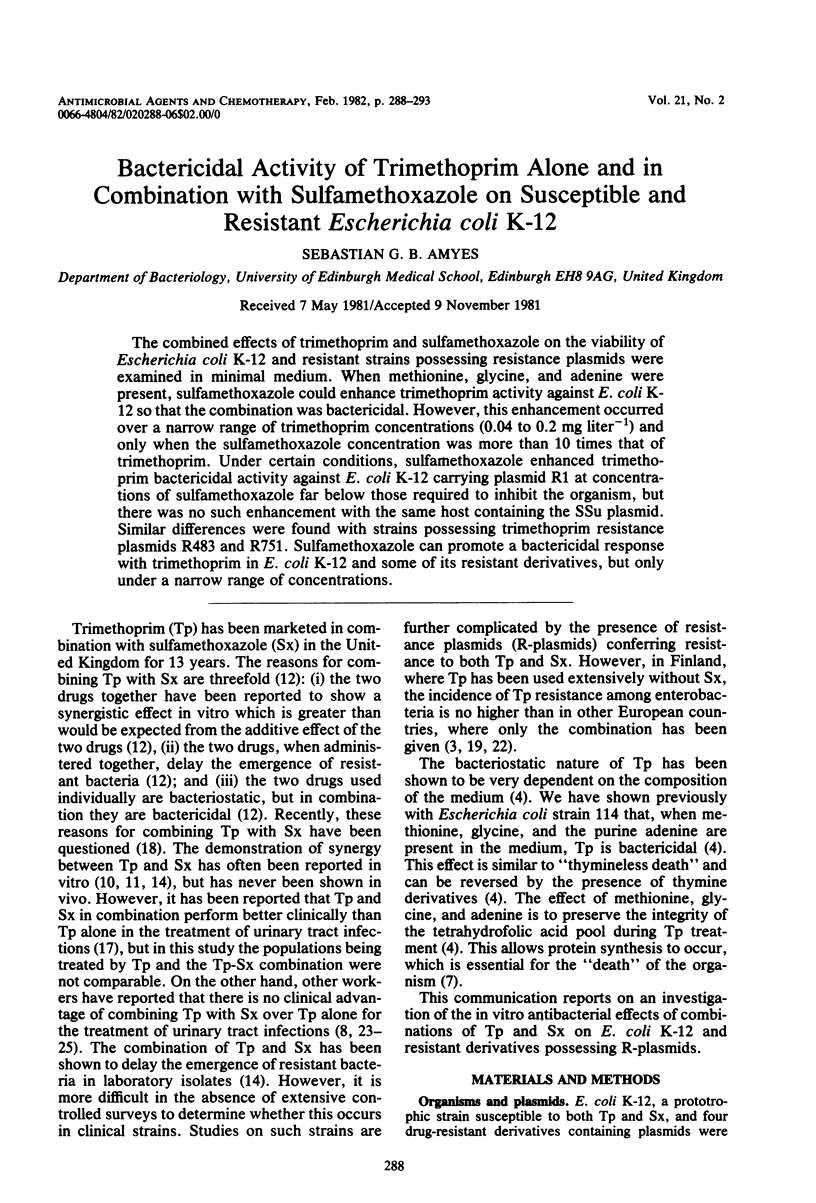

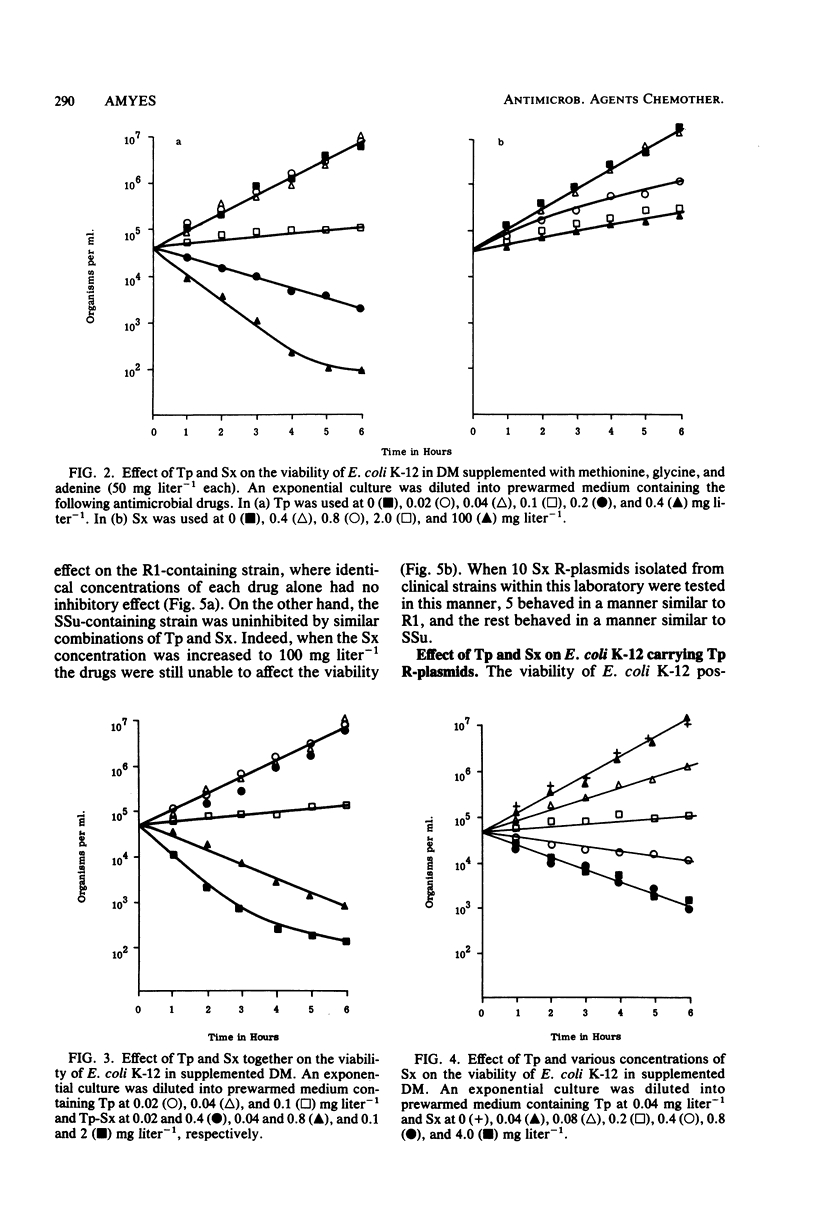
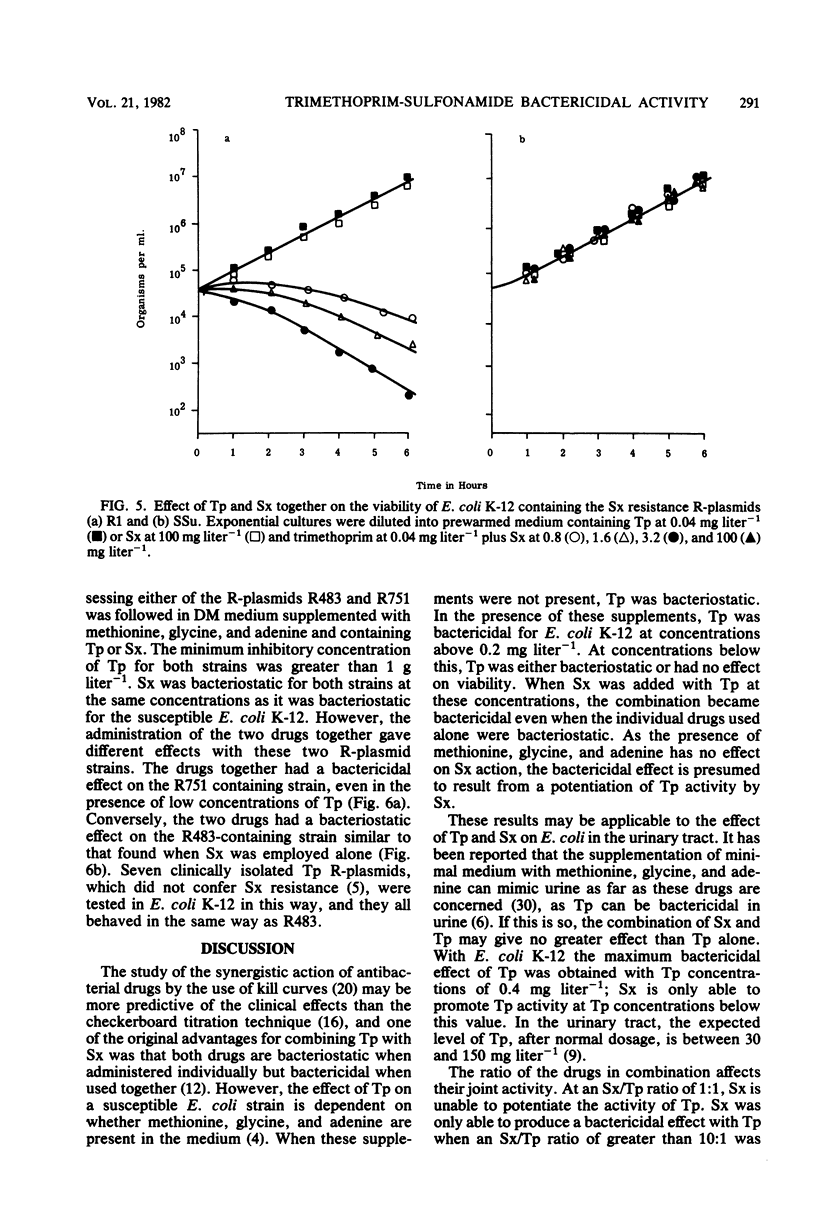
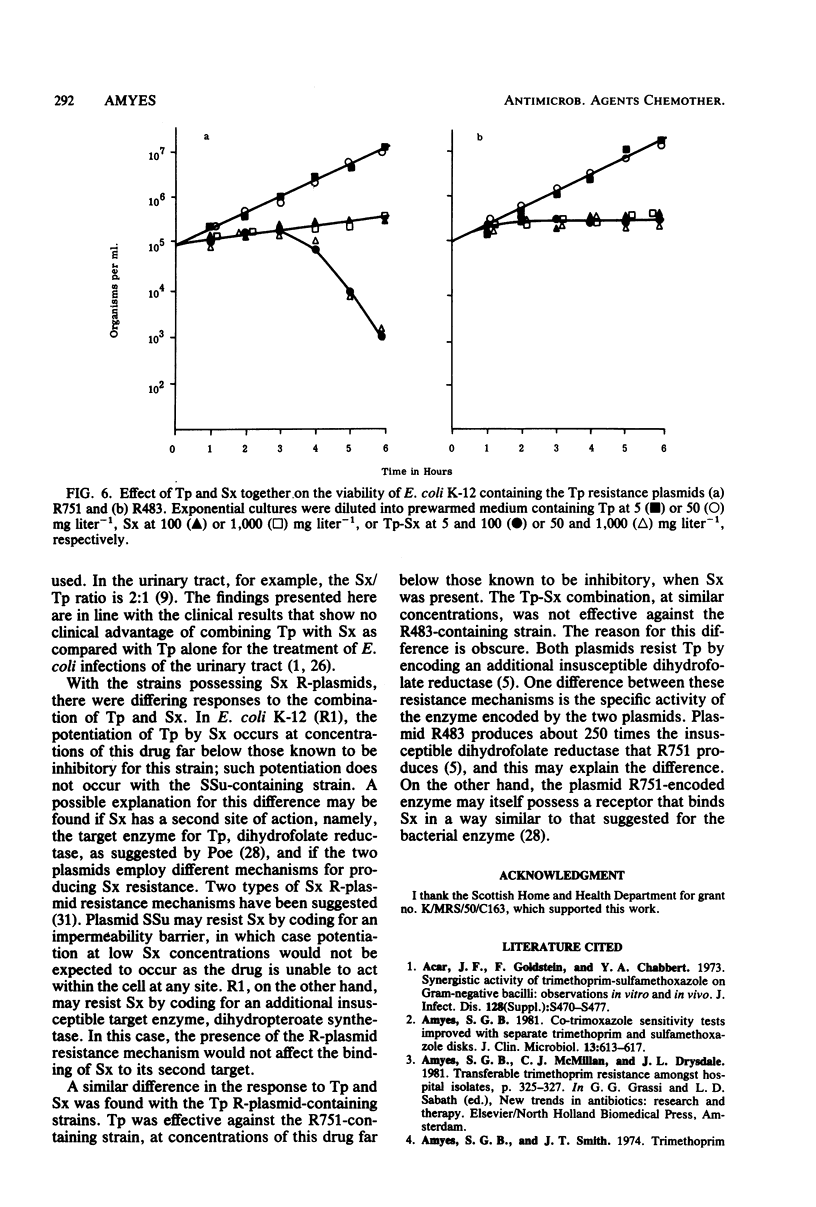
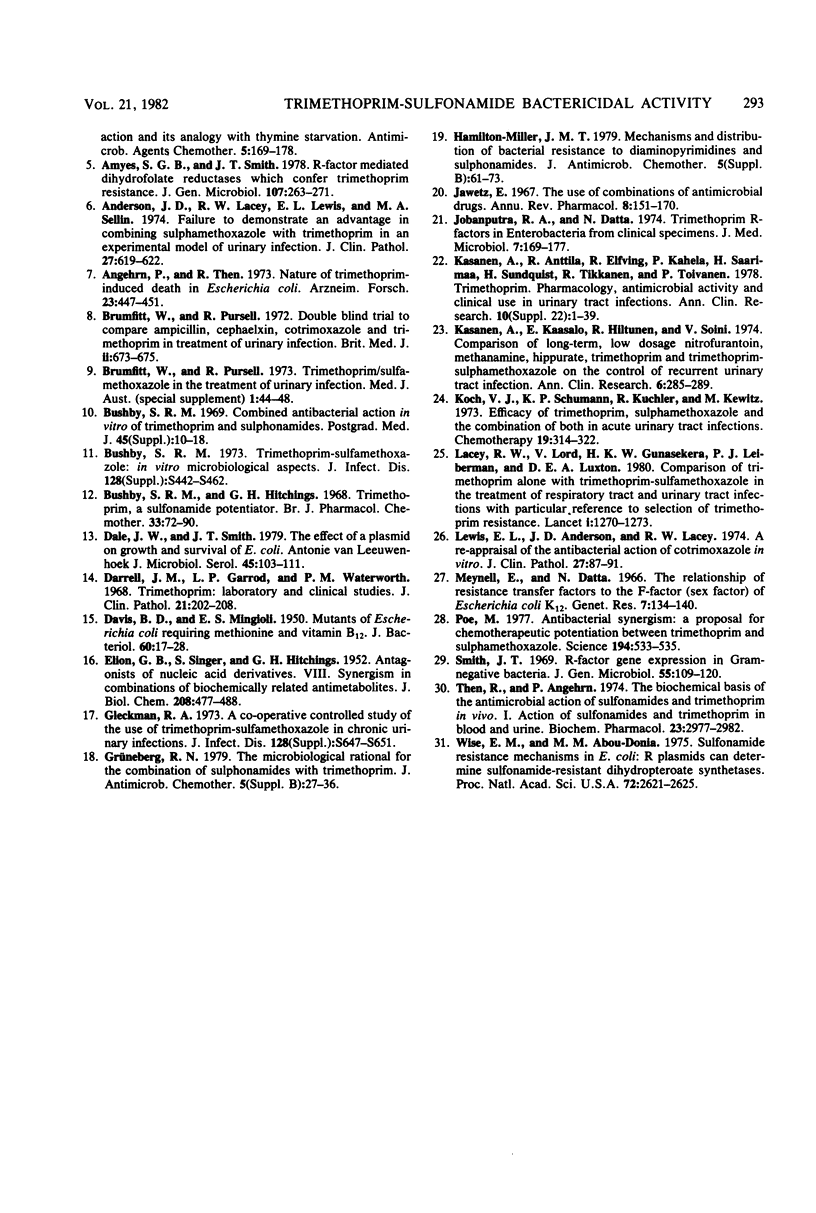
Selected References
These references are in PubMed. This may not be the complete list of references from this article.
- Amyes S. G. Co-trimoxazole susceptibility tests improved with separate trimethoprim and sulfamethoxazole disks. J Clin Microbiol. 1981 Apr;13(4):613–617. doi: 10.1128/jcm.13.4.613-617.1981. [DOI] [PMC free article] [PubMed] [Google Scholar]
- Amyes S. G., Smith J. T. R-factor mediated dihydrofolate reductases which confer trimethoprim resistance. J Gen Microbiol. 1978 Aug;107(2):263–271. doi: 10.1099/00221287-107-2-263. [DOI] [PubMed] [Google Scholar]
- Amyes S. G., Smith J. T. Trimethoprim action and its analogy with thymine starvation. Antimicrob Agents Chemother. 1974 Feb;5(2):169–178. doi: 10.1128/aac.5.2.169. [DOI] [PMC free article] [PubMed] [Google Scholar]
- Anderson J. D., Lacey R. W., Lewis E. L., Sellin M. A. Failure to demonstrate an advantage in combining sulphamethoxazole with trimethoprim in an experimental model of urinary infection. J Clin Pathol. 1974 Aug;27(8):619–622. doi: 10.1136/jcp.27.8.619. [DOI] [PMC free article] [PubMed] [Google Scholar]
- Angehrn P., Then R. Nature of trimethoprim-induced death in Escherichia coli. Arzneimittelforschung. 1973 Mar;23(3):447–451. [PubMed] [Google Scholar]
- Brumfitt W., Pursell R. Double-blind trial to compare ampicillin, cephalexin, co-trimoxazole, and trimethoprim in treatment of urinary infection. Br Med J. 1972 Jun 17;2(5815):673–676. doi: 10.1136/bmj.2.5815.673. [DOI] [PMC free article] [PubMed] [Google Scholar]
- Brumfitt W., Pursell R. Trimethoprim-sulphamethoxazole in the treatment of urinary infection. Med J Aust. 1973 Jun 30;1(2 Suppl):44–48. doi: 10.5694/j.1326-5377.1973.tb111187.x. [DOI] [PubMed] [Google Scholar]
- Bushby S. R. Combined antibacterial action in vitro of trimethoprim and sulphonamides. The in vitro nature of synergy. Postgrad Med J. 1969 Nov;45(Suppl):10–18. [PubMed] [Google Scholar]
- Bushby S. R., Hitchings G. H. Trimethoprim, a sulphonamide potentiator. Br J Pharmacol Chemother. 1968 May;33(1):72–90. doi: 10.1111/j.1476-5381.1968.tb00475.x. [DOI] [PMC free article] [PubMed] [Google Scholar]
- DAVIS B. D., MINGIOLI E. S. Mutants of Escherichia coli requiring methionine or vitamin B12. J Bacteriol. 1950 Jul;60(1):17–28. doi: 10.1128/jb.60.1.17-28.1950. [DOI] [PMC free article] [PubMed] [Google Scholar]
- Dale J. W., Smith J. T. The effect of a plasmid on growth and survival of E. coli. Antonie Van Leeuwenhoek. 1979;45(1):103–111. doi: 10.1007/BF00400783. [DOI] [PubMed] [Google Scholar]
- Darrell J. H., Garrod L. P., Waterworth P. M. Trimethoprim: laboratory and clinical studies. J Clin Pathol. 1968 Mar;21(2):202–209. doi: 10.1136/jcp.21.2.202. [DOI] [PMC free article] [PubMed] [Google Scholar]
- ELION G. B., SINGER S., HITCHINGS G. H. Antagonists of nucleic acid derivatives. VIII. Synergism in combinations of biochemically related antimetabolites. J Biol Chem. 1954 Jun;208(2):477–488. [PubMed] [Google Scholar]
- Hamilton-Miller J. M. Mechanisms and distribution of bacterial resistance to diaminopyrimidines and sulphonamides. J Antimicrob Chemother. 1979 Nov;5(B):61–73. doi: 10.1093/jac/5.supplement_b.61. [DOI] [PubMed] [Google Scholar]
- Jawetz E. The use of combinations of antimicrobial drugs. Annu Rev Pharmacol. 1968;8:151–170. doi: 10.1146/annurev.pa.08.040168.001055. [DOI] [PubMed] [Google Scholar]
- Jobanputra R. S., Datta N. Trimethoprim R factors in enterobacteria from clinical specimens. J Med Microbiol. 1974 May;7(2):169–177. doi: 10.1099/00222615-7-2-169. [DOI] [PubMed] [Google Scholar]
- Kasanen A., Anttila M., Elfving R., Kahela P., Saarimaa H., Sundquist H., Tikkanen R., Toivanen P. Trimethoprim. Pharmacology, antimicrobial activity and clinical use in urinary tract infections. Ann Clin Res. 1978;10 (Suppl 22):1–39. [PubMed] [Google Scholar]
- Kasanen A., Kaarsalo E., Hiltunen R., Soini V. Comparison of long-term, low-dosage nitrofurantoin, methenamine hippurate, trimethoprim and trimethoprim-sulphamethoxazole on the control of recurrent urinary tract infection. Ann Clin Res. 1974 Oct;6(5):285–289. [PubMed] [Google Scholar]
- Koch U. J., Schumann K. P., Küchler R., Kewitz H. Efficacy of trimethoprim, sulfamethoxazole and the combination of both in acute urinary tract infection. Clinical and pharmacokinetical studies. Chemotherapy. 1973;19(5):314–321. doi: 10.1159/000221470. [DOI] [PubMed] [Google Scholar]
- Lacey R. W., Lord V. L., Gunasekera H. K., Leiberman P. J., Luxton D. E. Comparison of trimethoprim alone with trimethoprim sulphamethoxazole in the treatment of respiratory and urinary infections with particular reference to selection of trimethoprim resistance. Lancet. 1980 Jun 14;1(8181):1270–1273. doi: 10.1016/s0140-6736(80)91732-8. [DOI] [PubMed] [Google Scholar]
- Lewis E. L., Anderson J. D., Lacey R. W. A reappraisal of the antibacterial action of cotrimoxazole in vitro. J Clin Pathol. 1974 Feb;27(2):87–91. doi: 10.1136/jcp.27.2.87. [DOI] [PMC free article] [PubMed] [Google Scholar]
- Meynell E., Datta N. The relation of resistance transfer factors to the F-factor (sex-factor) of Escherichia coli K12. Genet Res. 1966 Feb;7(1):134–140. doi: 10.1017/s0016672300009538. [DOI] [PubMed] [Google Scholar]
- Poe M. Antibacterial synergism: a proposal for chemotherapeutic potentiation between trimethoprim and sulfamethoxazole. Science. 1976 Oct 29;194(4264):533–535. doi: 10.1126/science.788154. [DOI] [PubMed] [Google Scholar]
- Smith J. T. R-factor gene expression gram-negative bacteria. J Gen Microbiol. 1969 Jan;55(1):109–120. doi: 10.1099/00221287-55-1-109. [DOI] [PubMed] [Google Scholar]
- Then R., Angehrn P. The biochemical basis of the antimicrobial action of sulfonamides and trimethoprim in vivo--I. Action of sulfonamides and trimethoprim in blood and urine. Biochem Pharmacol. 1974 Nov 1;23(21):2977–2982. doi: 10.1016/0006-2952(74)90272-x. [DOI] [PubMed] [Google Scholar]
- Wise E. M., Jr, Abou-Donia M. M. Sulfonamide resistance mechanism in Escherichia coli: R plasmids can determine sulfonamide-resistant dihydropteroate synthases. Proc Natl Acad Sci U S A. 1975 Jul;72(7):2621–2625. doi: 10.1073/pnas.72.7.2621. [DOI] [PMC free article] [PubMed] [Google Scholar]


